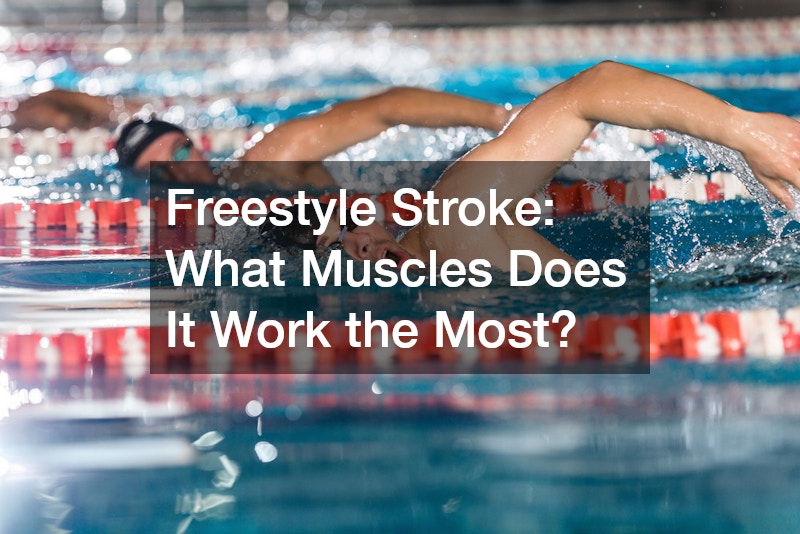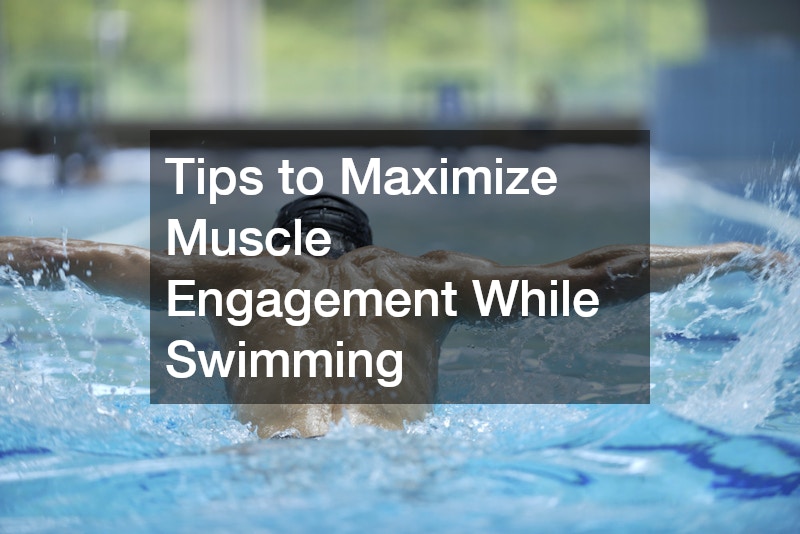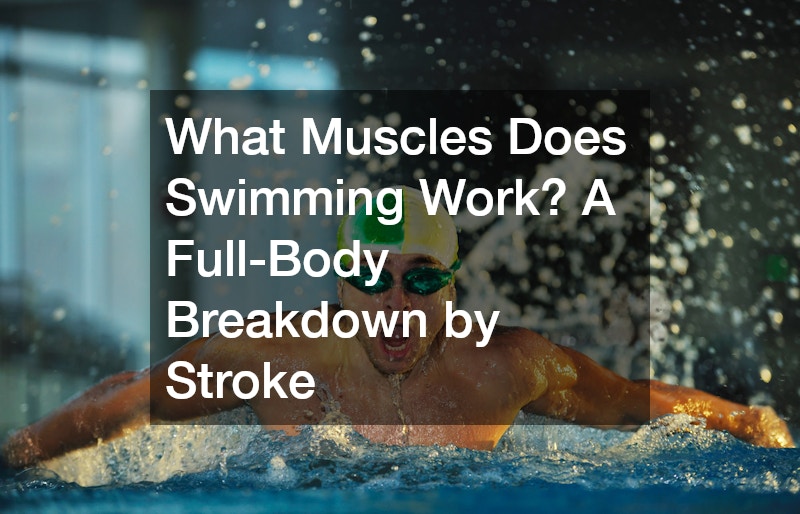
Swimming isn’t just a life-saving skill or a fun summer activity—it’s one of the most effective full-body workouts available. Whether you’re a casual swimmer or a competitive athlete, swimming engages nearly every muscle group in your body. From your shoulders and back to your core and legs, each stroke offers unique benefits and challenges.
This guide breaks down what muscles swimming works, analyzing the four primary strokes: freestyle, backstroke, breaststroke, and butterfly. We’ll explore the anatomy of each movement, how swimming builds strength and endurance, and why it’s so effective for both beginners and fitness enthusiasts.
Let’s dive in and explore how swimming transforms your body, one stroke at a time.
Why Is Swimming a Full-Body Workout?
Swimming is widely recognized as one of the best low-impact workouts available—but what gives it such a powerful, full-body effect? Unlike land-based exercises, swimming requires you to move through water, a substance significantly denser than air. This natural resistance challenges your muscles with every movement, making them work harder to propel you forward.
At the same time, your heart and lungs are actively supporting your effort, delivering oxygen where it’s needed. This combination of strength-building and aerobic activity makes swimming a well-rounded exercise that enhances endurance, tones muscles, and improves flexibility—all without stressing your joints.
Here’s why it’s such a great total-body exercise:
- Low-impact on joints, making it perfect for recovery and long-term sustainability
- Engages multiple muscle groups simultaneously
- Increases core stability and balance
- Enhances cardiovascular fitness and lung capacity
Now, let’s break down the muscles used in each swimming stroke.
Freestyle Stroke: What Muscles Does It Work the Most?

Freestyle, also known as the front crawl, is the most popular and fastest of all strokes. It’s often the first stroke swimmers learn and forms the foundation of many competitive routines.
Primary Muscle Groups Worked in Freestyle:
Upper Body:
- Deltoids (shoulders): Power the arm’s reach and recovery
- Latissimus dorsi (lats): Provide a strong pulling motion through water
- Trapezius and rhomboids (upper back): Stabilize and retract shoulders during arm motion
- Biceps and triceps: Assist in pulling and pushing water effectively
Core:
- Rectus abdominis (abs) and obliques: Stabilize body alignment and support rotation
- Erector spinae: Maintain posture and streamline body position
Lower Body:
- Quadriceps and hamstrings: Power flutter kicks
- Glutes: Engage during body rotation and kicking
- Calves: Assist in foot movement and propulsion
Fitness Benefits of Freestyle:
- Builds endurance and speed
- Promotes muscle symmetry
- Encourages core engagement for balance and efficiency
Backstroke Breakdown: Which Muscles Are Activated?
Backstroke is essentially the freestyle in reverse. Swum on the back, this stroke provides excellent aerobic conditioning while promoting good posture and spinal alignment.
Main Muscles Used in Backstroke:
Upper Body:
- Deltoids: Enable overhead arm recovery
- Lats: Drive the pulling phase under the water
- Triceps: Extend the arm through the push
- Forearms: Help with hand positioning and water catch
Core:
- Transverse abdominis: Supports stability on the water surface
- Obliques: Assist with body rotation
- Spinal erectors: Prevent the hips from sinking
Lower Body:
- Hip flexors and glutes: Drive the alternating kick
- Hamstrings and quadriceps: Support leg propulsion
- Calves: Enhance the snap of the foot during kick
Unique Benefits of Backstroke:
- Strengthens postural muscles
- Reduces neck and back strain
- Ideal for those with shoulder impingement or limited mobility
Breaststroke: Which Muscles Are Working Hardest?
Breaststroke is one of the oldest and most widely practiced strokes. Its rhythmic and symmetrical movements provide excellent muscle control and cardiovascular training.
Key Muscle Groups in Breaststroke:
Upper Body:
- Pectorals (chest): Used during the sweeping motion of the arms
- Biceps and forearms: Support the pulling phase
- Deltoids: Coordinate arm recovery above the chest
Core:
- Abs and obliques: Crucial for head and hip movement
- Lower back: Helps arch and lift during the glide
Lower Body:
- Adductors (inner thighs): Bring legs together after the frog kick
- Quadriceps and hamstrings: Power the wide kick movement
- Glutes and calves: Control the return phase of the kick
Functional Benefits of Breaststroke:
- Encourages flexibility, especially in the hips and knees
- Focuses on timing and coordination
- Low-intensity yet effective for muscle toning
Butterfly Stroke: The Ultimate Muscle Builder?
Often considered the most demanding stroke, the butterfly requires power, rhythm, and muscular endurance. It’s a go-to stroke for building explosive strength and improving anaerobic capacity.
What Muscles Does Swimming the Butterfly Work?
Upper Body:
- Deltoids and lats: Generate the circular arm recovery and underwater pull
- Triceps and biceps: Assist with the strong, simultaneous pull
- Pectorals: Push through the water forcefully
Core:
- Rectus abdominis and obliques: Initiate the dolphin kick from the torso
- Spinal extensors: Create a wave-like undulation
Lower Body:
- Hip flexors: Coordinate the dolphin kick
- Glutes and hamstrings: Propel the body in a whip-like motion
- Calves and feet: Snap the legs during the kick finish
Butterfly Stroke Benefits:
- Develops explosive strength
- Enhances muscular coordination
- Builds shoulder and back power
How Swimming Improves Core Stability and Balance
One of the most underrated aspects of swimming is how it strengthens the core. Regardless of stroke, swimmers must maintain a streamlined position, engaging abdominal, pelvic, and spinal muscles to remain efficient in the water.
Core Muscles Worked:
- Rectus abdominis: Maintains body alignment
- Obliques: Assist with twisting and rotation
- Transverse abdominis: Stabilizes the pelvis and spine
- Multifidus and spinal erectors: Provide postural support
These muscles don’t just work statically—they’re actively involved in the fluid motion of all strokes, helping swimmers maintain balance, flotation, and directional control.
Muscle Endurance vs. Strength: What Does Swimming Build More?
Swimming predominantly builds muscular endurance—the ability of a muscle to sustain repeated contractions over time. However, certain strokes and training variations can also promote muscle strength and hypertrophy.
To Focus on Muscle Endurance:
- Long-distance swimming
- Moderate pace with consistent technique
- Builds stamina in shoulders, legs, and core
To Focus on Muscle Strength:
- Sprint training and resistance drills (with paddles or drag suits)
- High-intensity intervals
- Strengthens arms, shoulders, and glutes
For best results, swimmers often complement water workouts with dryland strength training like resistance bands, pull-ups, and core exercises.
Does Swimming Build Muscle Like Weightlifting?
This is a common question among fitness enthusiasts. While swimming does tone and define muscles, it doesn’t typically result in large muscle mass like traditional strength training. That said, swimmers—especially competitive ones—tend to develop:
- Wide shoulders
- Toned backs and arms
- Lean, muscular legs
- Strong cores
For those seeking hypertrophy, combining swimming with weightlifting offers the best of both worlds: aerobic endurance and muscle gains.
Tips to Maximize Muscle Engagement While Swimming

To get the most out of your swim workouts, it’s essential to maintain good form and challenge your muscles regularly. Here are tips to boost your results:
✅ Use proper technique: Poor form reduces muscle activation
✅ Switch strokes: Engage different muscle groups
✅ Add resistance tools: Use paddles, fins, or drag suits
✅ Focus on form and power: Quality beats quantity
✅ Incorporate kick sets and pull sets: Isolate specific muscles
✅ Engage your core: Every stroke begins from the center
How Does Swimming Compare to Other Full-Body Workouts?
While many exercises claim to offer a full-body workout, swimming truly delivers on that promise thanks to the constant resistance of water and the coordination required across multiple muscle groups. Unlike running or cycling, which predominantly focus on the lower body, swimming activates both upper and lower muscles along with the core. It’s also easier on the joints, making it a preferred option for those with arthritis, injuries, or limited mobility. Compared to weightlifting or HIIT, swimming provides a balanced blend of strength and cardio without requiring impact-heavy repetitions.
Can Swimming Help With Muscle Recovery and Injury Rehabilitation?
Yes—swimming is frequently recommended for recovery and physical therapy due to its low-impact nature and gentle resistance. The buoyancy of water supports the body and reduces stress on injured joints and tissues while still allowing movement and mild exertion. Many rehabilitation programs incorporate swimming or aqua therapy to rebuild strength, restore range of motion, and enhance circulation without the risks associated with high-impact activities. It’s an ideal cross-training option for injured athletes or anyone easing back into regular exercise.
How Often Should You Swim to See Muscle Toning Results?
For noticeable toning and strength improvement, swimming at least 3 to 4 times per week is ideal. The key is consistency and stroke variety. Each session should last 30–60 minutes, incorporating both slow endurance laps and high-intensity intervals to activate different muscle groups. Mixing strokes—like freestyle, breaststroke, and butterfly—ensures balanced muscle development. Adding resistance tools like kickboards or pull buoys can accelerate toning, especially in the arms, legs, and core. With regular effort, visible results are often noticeable within a month.
Does Swimming Burn Fat While Building Muscle?
Absolutely. Swimming is an excellent fat-burning exercise that also builds lean muscle mass. Because it combines both aerobic and anaerobic exertion, it increases calorie burn while promoting muscle engagement. High-intensity intervals or stroke combinations can elevate your heart rate and stimulate fat loss, while continuous movement keeps muscles under tension, especially in the arms, back, core, and legs. Over time, this dual impact reshapes your body by decreasing fat percentages and enhancing muscle definition without bulk, making swimming ideal for those seeking a lean, athletic physique.
Conclusion: What Muscles Does Swimming Work? A Stroke-by-Stroke Recap
Swimming truly lives up to its reputation as a full-body workout. Each stroke offers unique benefits and targets specific muscles, but collectively, they engage your:
- Shoulders and upper back
- Chest and arms
- Core stabilizers
- Glutes, quads, and hamstrings
- Calves and feet
For swimmers and fitness enthusiasts alike, incorporating a variety of strokes ensures balanced muscular development, improved endurance, and better overall fitness. Whether you’re looking to build strength, stay lean, or rehab an injury, swimming offers an efficient and enjoyable way to transform your body.


